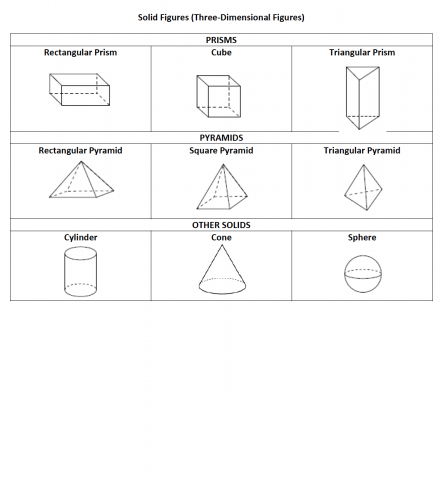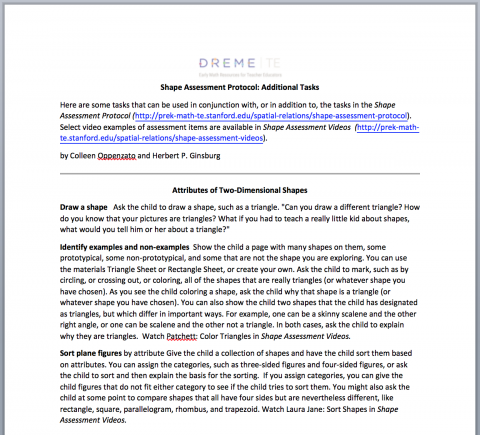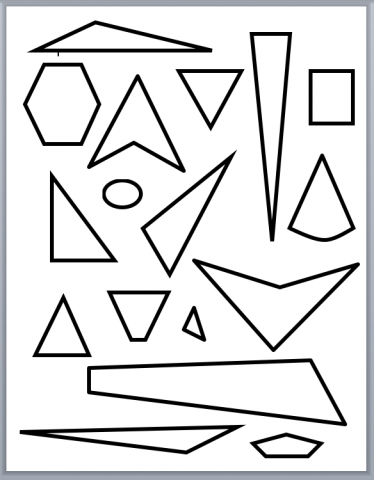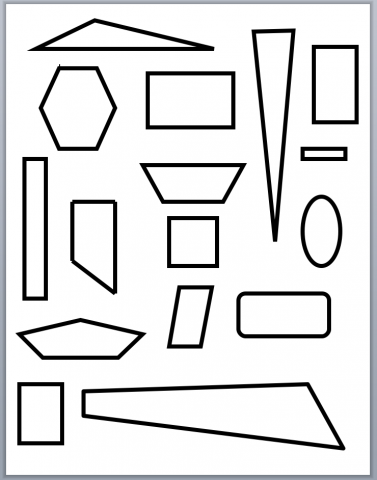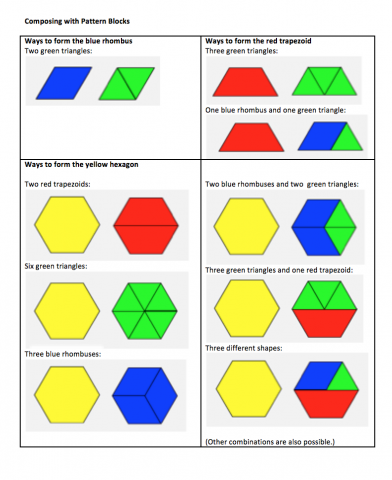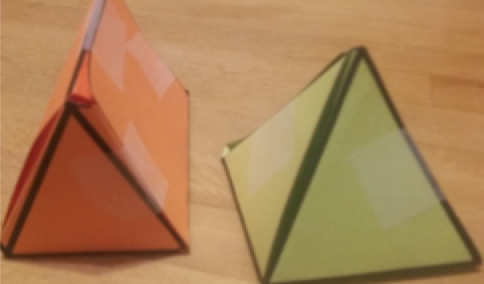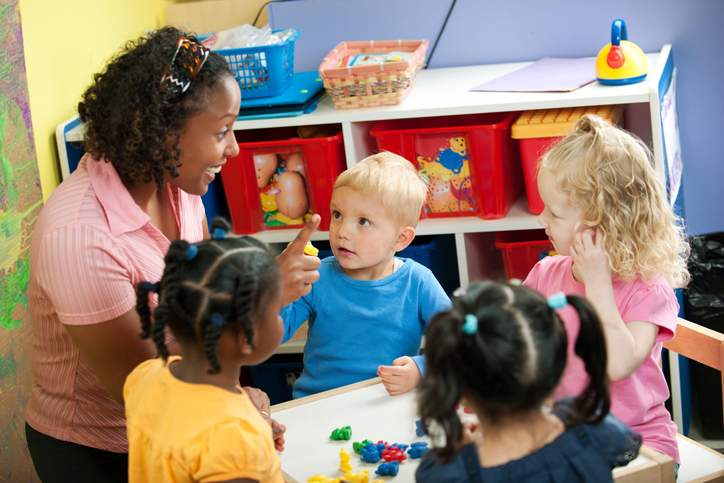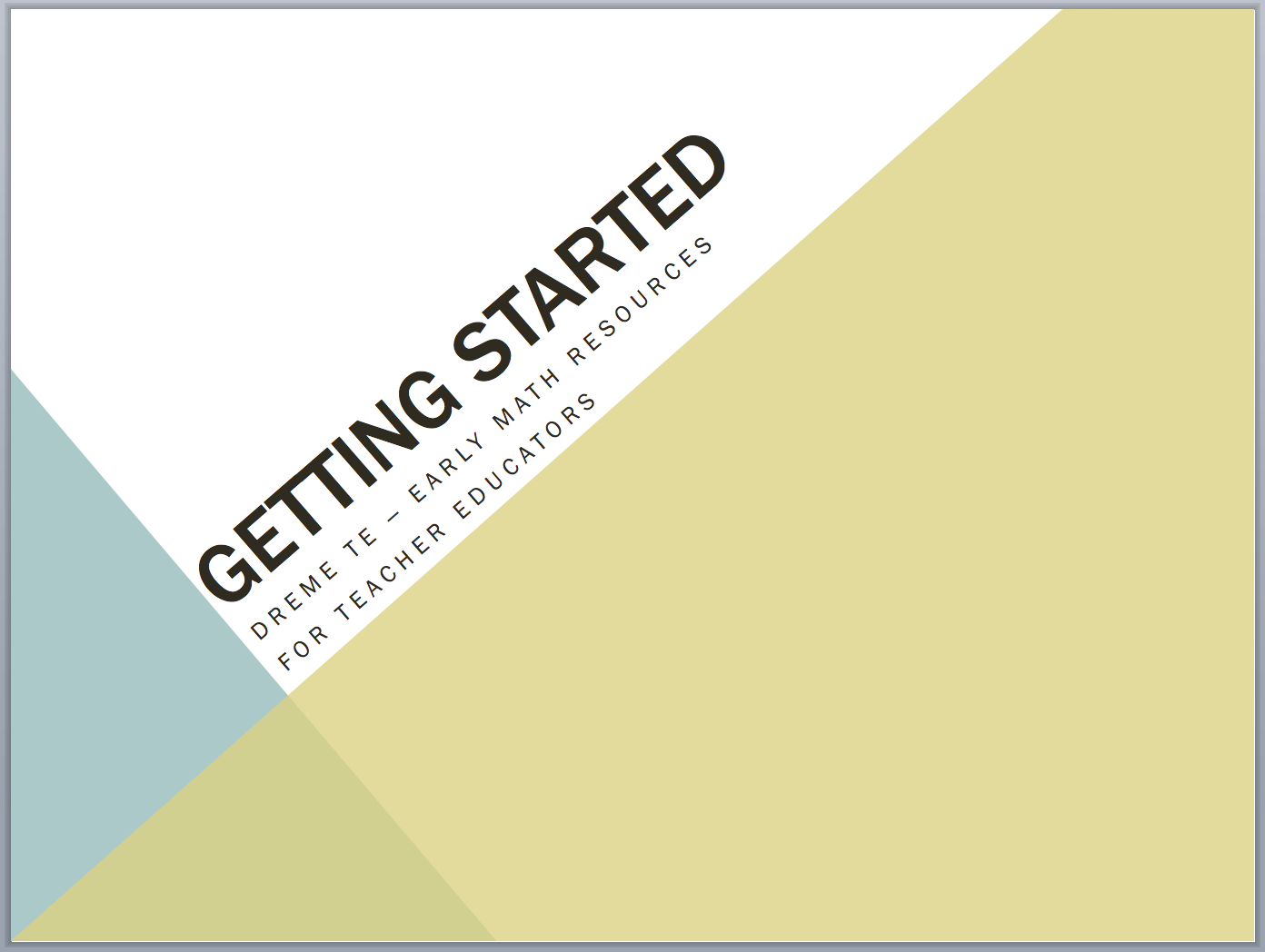These tasks are designed to help you assess children’s concepts of shape. The protocol begins with relatively simple concepts like attributes of two dimensional shapes and ends with the analysis of solid shapes.
Revised March 30, 2019.
The tasks in this protocol can help you explore these ideas about a child’s understanding of shape. Here are three ideas about shape that can be explored:
- Two-dimensional shapes can be defined and classified by key properties or attributes.
- Three-dimensional shapes have faces that are two-dimensional shapes.
- Shapes can be composed and decomposed to make new shapes.
The resource Math Thinking Conversations provides guidelines for how to use these kinds of tasks to explore a child’s mathematical understanding.
The tasks that follow have been organized according to the questions listed above. For more assessment tasks that can be used in conjunction with, or in addition to, the tasks below, see Shape Assessment Protocol: Additional Tasks (download below). Select video examples of assessment items are available in Shape Assessment Videos.
Attributes of Two-Dimensional Shapes
- Identify shapes Show the child several different shapes: triangles of different types (right angle, scalene etc.), squares, circles, and rectangles of different types (long thin, etc.). Ask the child to give you one of them. "Please give me a triangle." Follow up with, "How do you know this is a triangle?"
- Name shapes (prototypical) Show the child a prototypical shape such as an equilateral triangle or square. Ask the child what shape it is, and try to find out how the child knows. "What shape is this? How do you know? Can you describe it?” Turn the shape so it is no longer resting on its base. Ask, “Is this still the same shape?” Some children will say it is. Others may become confused about whether the shape is still the same or not. It is also important to make sure your question is clear. A young child, especially a child who is a dual language learner, may be more confused by the question or language than by the shape itself. Watch Gabriella: Square here and Luis: Square here.
- Name shapes (non-prototypical) Show the child another shape that is the same as the previous shape but is a non-prototypical shape. For example, if you showed the child a right triangle the first time, now show a non-prototypical triangle such as a scalene triangle or an “upside-down triangle.” Ask: "What shape is this? How do you know? Is it the same shape as the one before? Why?" Watch Alicia: Triangles here.
- Non-examples of shapes Show the child another shape that is not a triangle. The other shape can be clearly different, like a square or rectangle, or it can be a figure that looks like a triangle but really isn’t, as in the case of the figure with three sides, one of which is curved. "Is this a triangle? How do you know?"
- Select a plane figure based on attributes Give the child a collection of shapes, and describe one for the child to give you, not by name but by characteristics. (For example, "Give me a shape that has exactly three sides and three corners.") Switch roles and have the child describe a shape that you can then find. Ask the child if the shape you chose is correct.
Three-Dimensional (Solid) Figures
- Name a Three-Dimensional Figure Show the child a three-dimensional figure. Ask the child to name the shape if possible. "What is this called?" The name isn't very important. Provide the name if the child doesn't know.
- Identify Faces of a Three-Dimensional Figure Point to different faces of the figure and ask, "What shape is this? How do you know? Do you know the name of this part?"
- Real-World Solid Figures Give children a copy of Solid Figures (download below), showing pictures of solids (prisms, pyramids, cylinders, cones, and spheres). Provide real-world approximations of these objects, such as a tennis ball for a sphere, a shoebox for a rectangular prism, or a paper towel roll for a cylinder. Ask the child to point to the shape that is closest to the real-world object. "How do you know? Is it exactly the same? Can you think of something else that is this shape too?"
- Select a solid figure based on attributes Give the child a collection of solids, and ask for a shape with certain characteristics. (For example, “Give me a solid that has a face that is a square," or "Give me a solid that has a curved part.") "Is that the only one?" Switch roles and have the child describe a solid to you that you can then find.
- Match two-dimensional shapes to solids Give the child a collection of solids and place several two-dimensional shapes on the table that are faces of the solids. Ask: (point to a face on the solid) "What shape is this?" Point to the flat shapes on the table: "Can you find the shape on the table?" If the child is struggling, give only two choices and point to them, asking: "Is it more like this one or this one?"
Compose and Decompose Shapes
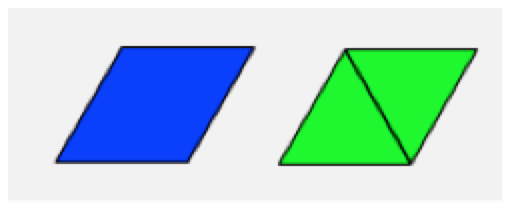 Compose shapes Ask a child to use two or more pattern blocks to form another pattern block. For example, ask the child to use green triangles to make one blue rhombus (two green triangles make the same shape as one blue rhombus). "How do you know your shape is the same? Can you show me how you know?" Other ideas can be found in Composing with Pattern Blocks (download below).
Compose shapes Ask a child to use two or more pattern blocks to form another pattern block. For example, ask the child to use green triangles to make one blue rhombus (two green triangles make the same shape as one blue rhombus). "How do you know your shape is the same? Can you show me how you know?" Other ideas can be found in Composing with Pattern Blocks (download below).
- Ask a child to form new shapes that do not match the pattern blocks. "Can you make a bigger triangle?" Four green triangles could do this. "Can you make a star?" One yellow hexagon and six green triangles, or one red square and four green triangles could do this.

- Ask the child to put two different shapes together to make a new shape. "What is your new shape?" For example, a child who puts a triangle and a square together may say, "a house." Encourage the child to make other new shapes and describe them. Some compositions may not have easily named shapes (e.g., a square and two triangles).

- Ask a child to form new shapes that do not match the pattern blocks. "Can you make a bigger triangle?" Four green triangles could do this. "Can you make a star?" One yellow hexagon and six green triangles, or one red square and four green triangles could do this.
- Decompose shapes Place two shapes together to make a new shape. For example, two congruent right triangles can make a rectangle. Challenge the child to take them apart. "What shapes do you have now?"
Early Math Collaborative at Erikson Institute. (2014). Big ideas of early mathematics: What teachers of young children need to know (First ed.). Boston: Pearson.
Sarama, J., & Clements, D. H. (2009). Early childhood mathematics education research: Learning trajectories for young children. New York: Routledge.
